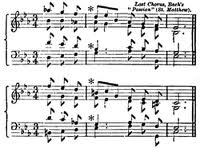And quantity brings us to proportion, and to the threshold of man’s mastery of sound to produce music. A length of string divided into two equal parts will, when plucked, give a pitch at what we call an octave above the original pitch of the full length. That is to say, in scientific terms, that the frequency of vibrations from the two lengths correspond at a ratio of 1:2, producing the same note, at a higher pitch – an octave above. Continuing to divide a length into three, four etc. produces a sequence of different notes at different pitches. The sonic intervals produced, just as the physical proportions, are progressively smaller and potentially infinite.1 It is on the basis of adjusting proportions to effect a change in pitch that the musical tradition has been developed around modes and scales, establishing a convention to the number of and distance between the intervals produced by the change in proportion. We shall consider the scale and the relationship between intervals when we come to look at music itself, but the important thing to notice for now is that the foundation of pitch is in the very matter of the body that resonates when struck, and that this matter forms the basis of the structure to the sequence of pitches produced: there is a primary pitch to a body, from which other pitches are produced by imposing a tension in that body; the more tension created in that body, the closer to the original pitch the sound produced is, without ever reaching it. The very fact that a scale is possible is that there is a home note, from which others are produced. All the notes of a scale are in reference to that home note and the relationship between that home note – the original free pitch – and the other pitches produced, is founded upon a tension within the body itself.
We note too here that this phenomenon we observe in tension applied to a string finds a correspondence as regards wind instruments in what is known as ‘over blowing’: by increasing the amount of air blown over a gap, the same sequence of pitches is produced as by changing the proportions in a plucked string. This is the particular characteristic of brass instruments, which, of all instruments involving breath, rely most on this phenomenon – the most basic of brass instruments (the bugle or horn) having no other means of controlling pitch. The difference here that concerns us is that in the case of strings, the pitch is generated from the instrument itself, in as much as it is the resonating of its own matter that is changed by the tension applied to it. In wind and brass instruments, however, the change in pitch is produced by the very breath of the instrumentalist, of the person playing the instrument. In this case, therefore, there is a more direct link with the living world, in that the change in pitch depends essentially on breath, the vital movement of a living being. Pitch as regards stringed instruments has a closer link with the physical, material world (We note, however, that it will be by vibrato, i.e. by touch, that the instrumentalist plays very finely on pitch with stringed instruments). We will consider later on the importance of the fact that the human voice is precisely a combination of these two elements: a ‘stringed’ instrument – i.e. vocal chords – that is played upon by breath.
1. We call to mind here, the remarks of Rameau on the link between music and mathematics: ‘Ce n’est pas la musique qui est une partie des mathémathiques, mais au contraire les sciences qui sont une partie de la musique, car elles sont fondeés sur les proportions, et la resonance du corps sonore engendre toutes les proportions.’ quoted by P. Marie-Dominique Philippe, Philosophie de l’art, p.79, note 3.


 De Broeders van Sint Jan hebben hun leven aan God gewijd, ten dienste van God en hun naasten. Zij willen leven volgens het Evangelie van Jezus Christus en zich door hun gebed en hun activiteiten inzetten voor jong en oud.
De Broeders van Sint Jan hebben hun leven aan God gewijd, ten dienste van God en hun naasten. Zij willen leven volgens het Evangelie van Jezus Christus en zich door hun gebed en hun activiteiten inzetten voor jong en oud.